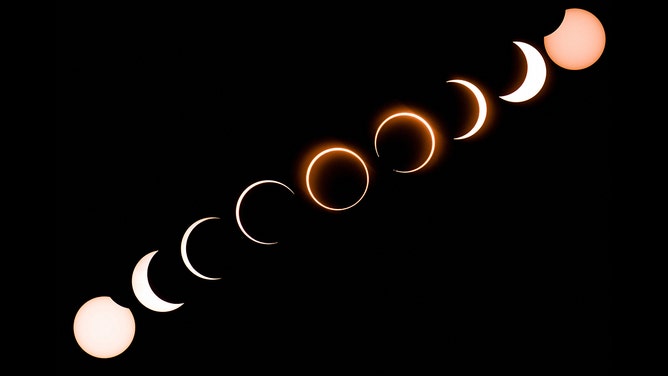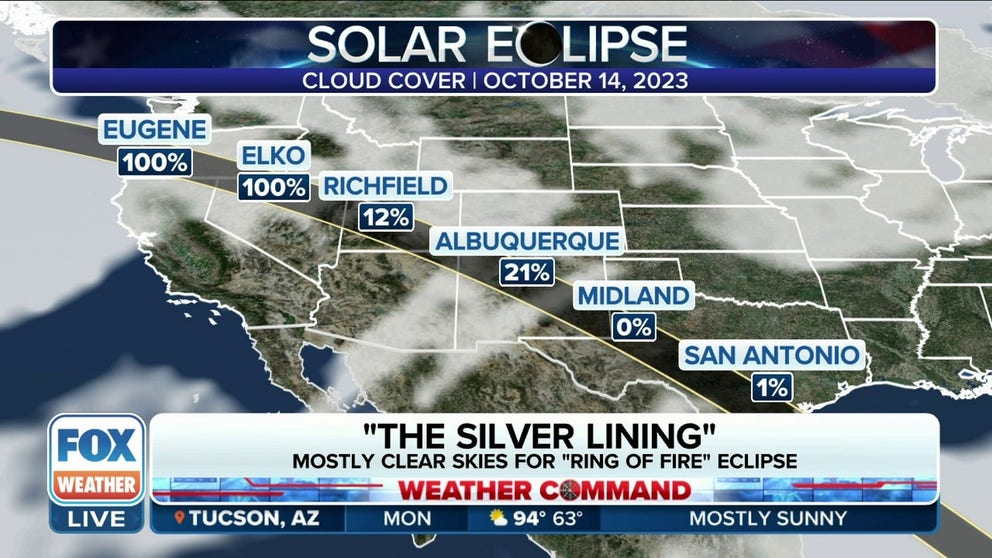Where to see the 'Ring of Fire' during the annular eclipse in Nevada
Winnemucca, Elko and Ely are included in the 125-mile-wide path of the maximum solar eclipse on Oct. 14.
Mostly clear sky for 'Ring of Fire' eclipse on Oct. 14
The forecast for the annular solar eclipse includes mostly clear skies for the path of maximum eclipse on Oct. 14. FOX Weather will be in Albuquerque for the eclipse coverage on Saturday.
ELY, Nevada – The annular solar eclipse will slice through Nevada on Saturday, Oct. 14, allowing those along the 125-mile-wide path of maximum eclipse to see the "ring of fire" for several minutes.
Nevada is one of nine states along the path of the annular solar eclipse, which stretches from Oregon to Texas. The peak solar eclipse will be visible in Nevada from the northwest border with California and Oregon to the state line with Utah.
Here's what you need to know about viewing the annular solar eclipse in Nevada.
What is an annular solar eclipse?
An annular eclipse is not a total eclipse, as the Moon doesn’t entirely block the Sun’s light – only 90%. An annular eclipse happens when the Moon is at its farthest point in its orbit of Earth. During the maximum eclipse, known as annularity, the light from the Sun peaks out around the Moon, creating the "ring of fire" the annular eclipse is known for.

This composite image shows the moon as it moves in front of the sun in a rare "ring of fire" solar eclipse as seen from Tanjung Piai in Malaysia on December 26, 2019.
(SADIQ ASYRAF/AFP / Getty Images)
Unlike a total solar eclipse, you will need to wear special eclipse glasses during the entirety of the annular eclipse. Taking the glasses off at any point, even during the maximum eclipse, is unsafe.
SOLAR ECLIPSE FORECAST: SOUTHWEST LIKELY TO HAVE BEST VIEWING CONDITIONS FOR OCTOBER 'RING OF FIRE'
Where can I see the ‘ring of fire’ in Nevada?
If you're watching the eclipse in Nevada, you have many options to be along the path of maximum eclipse, and the entire state will experience at least a partial eclipse.
Winnemucca, Elko and Ely are included in the 125-mile-wide maximum eclipse path.

Great Basin Bristlecone pine tree at night with stars in the background. (Image: NPS)
(National Parks Service)
There is no better time to enjoy fall outdoors than during a celestial event like a solar eclipse. Several National Parks are included on the annular solar eclipse path or are just outside the path of the "ring of fire." In Nevada, the Great Basin National Park will experience annularity on Saturday morning.
UTAH'S CANYONLANDS NATIONAL PARK PREPARES FOR OCTOBER SOLAR ECLIPSE CROWDS
According to the National Parks Service, White Pine County, Nevada – home to Great Basin National Park-- will be a premier destination to view the 2023 annular solar eclipse.
When is the solar eclipse in Nevada?
The eclipse in the U.S. begins in Oregon just after 8 a.m. PDT, and the partial eclipse ends in southeastern Texas at 1:33 p.m. CDT.
Partial eclipse views and the "ring of fire" will vary by a few minutes for those in Nevada further east along the eclipse path. The partial eclipse begins just after 8 a.m. across Nevada.
The maximum eclipse, when 90% of the Sun is covered, happens at 9:24 a.m. in Elko and will last over 4 minutes.
At Great Basin National Park, annularity happens for just under 4 minutes beginning at 9:26 a.m.
A partial eclipse will be visible for over 2 hours in Las Vegas beginning at 8:08 a.m., with about 80% of the Sun covered at 9:26 a.m.
What will the weather be like in Nevada for the solar eclipse?
Temperatures in the low 70s will make for pleasant viewing in Nevada during annularity, but clouds may be around to interfere with prime viewing conditions.
Full cloud cover is forecast along the eclipse path in Winnemucca and Elko for Saturday.
The National Parks Service warns that October in Nevada can be quite cold, including below-freezing temperatures overnight. If you plan to camp, bring warm layers.

(FOX Weather)
